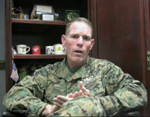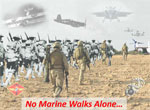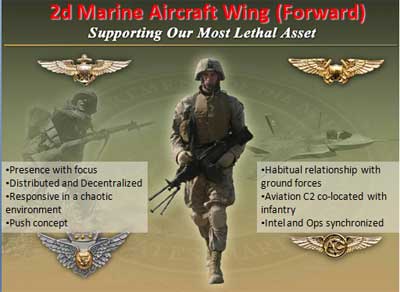
On November 9th, Brigadier General Walsh discussed his recent experiences in Iraq (watch video abstract).
In December 2008 he became the Commanding General of the 2nd Marine Aircraft Wing Forward and deployed to Operation Iraqi Freedom on November 3rd and 2nd MAW (Fwd) was deactivated on Thursday 19 November.
Brigadier General Walsh is particularly well suited to discuss the role of airpower because of his extensive background in aviation. He served in Washington with the Deputy Commandant for Aviation as the principal deputy, and in this position developed significant familiarity with the latest USMC aviation platforms, including the F35-B. He has extensive experience in dealing with the USAF and is very knowledgeable with regard to the USAF’s approach to air-battle management, so his comments on how the USMC has used aviation in Iraq, and the growing requirement for integration between air and ground elements is significant for the USAF and its relationship with the US Army as well. He was an instructor at the U.S. Navy Fighter Weapons School (Top Gun) and is a decorated Marine Corps Aviator.
A Strategic Shift In the Use of Manned Air
During General Walsh’s time in Iraq, there was a double transition underway. The first transition was the acceleration of stability operations. The second was the growing collaboration with the Iraqis in shaping their evolving capability to provide for their own internal security. This meant that the air element for the USMC had two crucial tasks:
-
to support US force as they began to withdraw and prepare for their exit role as Iraqi advisors;
-
to assist the Iraqis in shaping operations to provide for their own security.
As such, the core role of the USMC air was largely non-kinetic but with a residual kinetic role. The non-kinetic role needs to be understood as a presence and support role. The presence role was robust and significant; and General Walsh argued that the metrics for this significant airpower role are not well understood. “One can measure the effects of kinetic strike; it is more difficult to measure the effects of presence.”
Put in its simplest terms, General Walsh provided a core understanding to the strategic shift in the use of manned air in the COIN environment.
The shift is from shaping air around precision-strike to shaping air to provide collaborative presence.
– The Challenge of D.O. : the Absence of Rear Area
At the heart of the challenge is that “you are not dealing with one large formation on attack; the forces are very decentralized and very distributed. You are dealing with a very large area and with a dispersed force. You are dealing with little formations all over Anbar province, which is 250 miles by 150 miles in area. You have companies and platoons split over a large territory, which you have to support with limited assets. There is no rear area; there is no safe area.”
General Walsh went on to characterize the situation facing the COIN (Counter-Insurgency) military force. “The enemy can hit you anywhere; the enemy gets a vote is how I characterize it. We are not on the offensive; we are on the defensive. Both the enemy and we are living among the people, and the challenge is to get them on our side. If they are on our side they will give us credible information upon which we can act. But to know that level of detail you have to be distributed or dispersed.”
For the Commanding Officer, the challenge is simply the following: “How does aviation provide support in such a chaotic environment? Just as the guy on the ground is not certain of what is about to happen, so does the pilot trying to support those ground elements: all must deal with managing uncertainty.”
– Measuring the Effect of Presence
General Walsh’s answer revolved around the shift from precision strike to presence. Air presence was significant on three major levels for the USMC during this period in Iraq.
- First, presence was crucial to support the Marine on the ground. This could be lift, it could be overwatch, it could be an ability to provide fire support, it could be to fly low to demonstrate to the population that the ground element had significant firepower available, it could be to deal with the disparate strikes to which the ground forces were still subject to from a dispersed enemy. “A lot of times, Marines on the ground would ask us to come down lower so that they could see us. How do you measure that effect?” General Walsh characterized this concept as “no Marine walks alone.”
 When a Marine is operating “outside of the wire,” the role of airpower is to provide protection and support to that Marine. He gave an example of dealing with an IED-event. “When you have a vehicle blown with an IED and have the road all of a sudden divided into two slow moving small lanes of vehicles, how do you know who is in those vehicles? How do you know what they are going to do? You can wait a long time for the clearing vehicles to show up, especially as we drew down combat posts. A request would come in: Please bring in a fighter for presence to show you are there. How do you measure that effect?”
When a Marine is operating “outside of the wire,” the role of airpower is to provide protection and support to that Marine. He gave an example of dealing with an IED-event. “When you have a vehicle blown with an IED and have the road all of a sudden divided into two slow moving small lanes of vehicles, how do you know who is in those vehicles? How do you know what they are going to do? You can wait a long time for the clearing vehicles to show up, especially as we drew down combat posts. A request would come in: Please bring in a fighter for presence to show you are there. How do you measure that effect?” - Second, it could be re-assurance to the population. As the Iraqi leadership began to perform more functions, there was a remaining need to reassure the population that support could be provided throughout the country to the Iraqi allies. “For example, when the provincial government was to be seated in Al Anbar in June 2009, there was an Al Qaeda threat to Ramadi. The Governor asked us to fly our F-18s at 5000 feet to reassure the population and to deter any threats.”
- Third, it could be presence to deter attacks from a dispersed adversary. The pop-up capability of an adversary blended into a civilian population meant that air assets were in demand to come in and to support the ground elements on an ad hoc, and on-call role. As an example of the challenge of confronting attacks in a dispersed environment challenge, General Walsh gave this example. “I was on the ground; we were stopped at a check point and the check point came under motor fire. Several vehicles in front of us were destroyed. All hell was breaking loose with mortars coming in every few seconds. We did not know where the things were coming from. We of course had no battery radar. We called in some F-18s and the minute the planes showed up the firing stopped; the enemy figured out that the F18s would know where they were with the obvious consequences. How do you measure this effect?”
– Airpower All the More Crucial for Retrograde Operations
Indeed, General Walsh underscored that as the US forces withdraw, there was demand for more – not less – airpower. This happened on several levels.
- On one level, this was due to the drawdown of the number of combat posts, which supported operations in Iraq. American forces continued to work with Iraqi forces but now had to commute from distance to do their work, rather than being in close proximity to combat posts. This meant that airpower had to provide regular support to the transit of US forces working with Iraqis. “At one point we had 140 combat posts; while we were there we went from 36 to 4 combat posts; so air was relied on more frequently for convoy protection. As we drew down combat posts and associated capabilities, air was relied on for capabilities which had earlier been largely provided by the ground forces.”
- On another level, this was due to the need to protect the convoys moving equipment out of Iraq. “”As you close down and do retrograde, you have to move further out in road miles and that requires air support.”
- In addition, transport needs to move support elements to work with Iraqis increased demands for air transport. “We were increasingly asked to provide support for partnering operations.”
Looking for Innovative Con-Ops in a “Distributed Chaos” Environment Or The Art of “Managing Uncertainty”
– COIN: A Very Different Con-Ops Planning
General Walsh underscored that the con-ops for doing presence missions is considerably different from doing strike-oriented, offensive operations. With an offensive operation, air power can be tasked in advance, targets identified and air battle management focus is upon tempo of operations. With a presence-focus, which characterizes counter-insurgency (COIN) operations, tasking is on the fly, and not orchestrated 48-72 hours in advance.
To do the on the fly mission planning, the ground and air elements would work with common mission planning software to identify the tasks which the ground element would do on a day-to-day basis. The pilots would go airborne with a set of 4-5 taskings for the support of the ground forces, and would shift among these taskings as the ground forces would demand. The ground forces would identify in the mission software and web-based communication system what their schedule for the day was, and what their intentions for the day were. These intentions drove the taskings for the air element.
“The Marines are outside of the wire, how do we support them? We start with windows with regard to missions (i.e. Sons of Iraq payments, a security patrol known in advance, a battalion commander is going to meet the mayor, etc.). We determine the patterns of movement and look for movement clusters and then determine support in the air to support those movement clusters. Rather than carrying ordinance to cover a target, we are going airborne to support demands shaped by the most likely cluster of activities.”
– Collaborative Support and Operations: The Key Role of BFT
In effect, the C4ISR focus for precision strike support for a conventional operation was being replaced by a CISR D approach, in which shared decision-making between the ground and air elements was shaped as tasks were identified and means to fulfill those needs were defined in a real-time or near-real time environment.
In addition, a push concept for air operations was adopted. In the push concept, air elements would be launched in support of the ground forces, and the selection of the taskings would be taken from the pre-planned presence support list, and adjusted as pop-up challenges emerged. Rather than the USAF approach of having air power up with weapons in place to strike on demand targets, the USMC aviators worked with the ground elements before launching to determining the range of needs likely to be required based on the ground forces intent.
A key technology highlighted by the push concept is blue force tracking. Because BFT identifies where the ground elements are located in real time AND provides a texting tool, BFT can be a crucial tool for the air element. “I can do my operations with real knowledge of where the ground elements are located to support them. It goes from being a tool to reduce fratricide in a fast moving offensive operation to becoming a key tool to allow me to do collaborative support and operations. Frankly, all of our fixed wing aircraft should have BFT on them and I hope F-35 will have as well.”The presence focus for the air element also is changing the role of the Direct Air Support Center or DASC.
Historically, the DASC functioned as an air traffic controller similar to the FAA controllers in managing air-space and providing assets against targets. In the push environment, the DASC has become a decision-making element for the operations. Which airborne elements are most relevant to the evolving on the fly needs for the ground element, understood not in precision-strike terms, but presence terms.
“The DASC has become a battle manager in an operations sense; this is a whole new concept. Historically, there were usually not enough airplanes to do the tasks. So the task for the DASC was maintaining scarce assets against targets. The DASC operated like my grandmother operating as a telephone operator connecting lines at the console. The pilot was told where to go with no situational awareness. They were directed assets. Now you have more air than you have pre-planned targets. Now you have to know what the ground teams are doing and then allocate resources against a fluid demand structure. You are operating within distributed chaos. You are functioning as an enhanced 911 operator.”
– Air-Ground Integration: A Return To Investment for the USMC
The presence role which General Walsh sees as central to COIN operations is facilitated by the institutional investment which the USMC has put into air-ground integration. The USMC has pushed air ground integration down to the company level. Whereas the USAF will have a limited presence within the US Army, the USMC has significant aviator presence in the USMC ground element.
“What helps us is the number of pilots or air officers or Forward Air Controllers (FACs) integrated with the ground forces. When we have the FACs down to the company level as well as regiments and divisions. This gives us a significant number of nodes or fingers out there to integrate with the ground forces.”
General Walsh noted the difference with the USAF and the US Army. “When the 82nd Airborne replaced the USMC force, the USAF had one captain as a air liaison officer; we have 12 for every one captain that the USAF has. (…) When we have the F-35 out there, we will have a very significant flying combat system overhead which can work with this distributed command element. The processing power of the aircraft and the software on board which will allow us to support directly overhead our ground forces will be an exponential increase in capability. But this capability will be built upon the organizational investment and the habitual relationship we have between the ground and air elements.”
Also central to the USMC is having a single command element controlling the battlespace. Whereas you can centralize command, you cannot centralize control in a COIN environment, according to General Walsh. “For the air element to be effective, it must be able to provide support in a distributed control environment, and this really can only work with significant integration between the ground and air forces through facilitating on-the fly “pre-planning.”
The institutional investment has been enhanced by the use of new mission planning technologies as well. For example, the Command Post of the Future was a key tool, which the USMC used, in better integrating air and ground operations. “The CPOF is an army tool which puts in all of the plans, identifies the boundaries of the groups, provides a ground overlay, identifies battlespace ownership, Con-Ops of the operation. It provides information to shape collaboration. The commander then can determine: “OK, here is where I am going to put my Cobras, my F-18s etc”, then the ground commanders can request these assets to support ground needs.”
– Ground-Manned Air-Unmanned Air Assets: A Complementary Triade
The USMC experience in Iraq, which is being transferred to Afghanistan, is re-shaping as well the way the USMC will operate in its CONUS-based air bases. The same approach to using mission planning and integration to give the base commanders a better grasp of the operation of the air assets.
General Walsh added as well that the unmanned systems are very useful in providing persistent stare for ground engagements. Yet they are limited in terms of effectiveness by simply generating data, which are not useful unless they are integrated with ground presence. “If I know there is a problem but I am far away, what use is that?”
Another problem is the distance from the operation for a UAV controller back in the United States. “For example, a ground controller for a UAS back in the US is viewing the entry into a house or area and trying to determine location of possible insurgent and trying to determine whether I place a hellfire or not on the target. So for the Marine on the ground who do you trust more, the guy making the decision back in the US or the USMC air element with whom I am directly talking and is directly overhead?”
The ability to work the Osprey with UAS will also be a significant improvement: “In Afghanistan, when the UAS tracks the bad guys, we will be able to use the Osprey to drop Marines close to the bad guys and then to prosecute. Just having data identifying a problem is not going to close the deal: having the guys on the ground get there quickly enough to make a difference will.”
General Walsh concluded by emphasizing the central role of the manned element in playing the presence role within COIN. “The ability of the ground and air elements to work together to shape presence in a COIN environment is central to re-assurance of the Marine on the ground, to the population you are trying to reassure, and to the ability to strike an adversary who can pop up without warning.”
———-
***Posted November 30th, 2009





